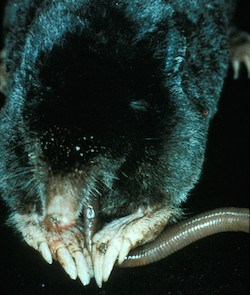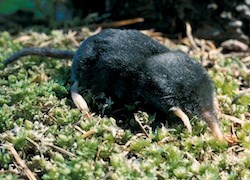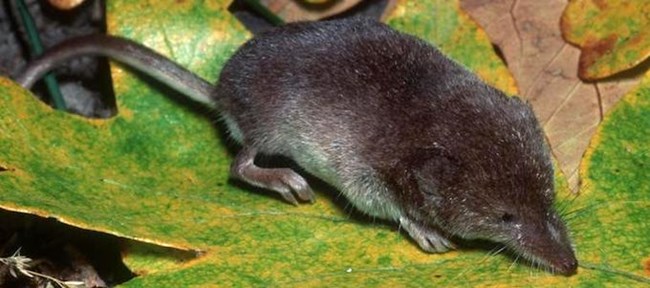|
The insectivore group of mammals includes moles and shrews. Though similar in appearance to rodents, insectivores lack the prominent incisor teeth that distinguishes rodents. Instead they have numerous sharp teeth for hunting and eating insects. Insectivore SpeciesMoles - family Talpidae
NPS Photo Coast MoleScapanus orarius Coast moles have dark grey fur with a silvery sheen, which can turn more brownish in summer. Their tails are pinkish with few hairs, as is the tip of the nose. They have large, hairless forefeet that turn outwards. Moles use their large feet and claws to tunnel easily through the soil in search of their preferred food of earthworms. They also eat other insects and some vegetation. Coast moles leave behind piles of discarded soil called "molehills" and play an essential role in aerating soil. They can be found in meadows and some forests. Townsend's MoleScapanus townsendii The largest mole in North America, Townsend's moles have short black fur, short pink tails, long snouts, and very large forefeet. The claws on the forefeet are flat and heavy, designed to easily dig through soil. Like the related but smaller coast mole, Townsend's moles primarily eat earthworms, but also insects, larvae, and some vegetation. They prefer loose soil at lower elevations. 
NPS Photo Shrew MoleNeurotrichus gibbsii Shrew moles have black fur, scaly feet, and long tails. Unlike other moles, shrew moles spend some time above ground so their forefeet are smaller. Also, while their claws are long, they are not flattened like with other moles. Instead of digging through soil, shrew moles tunnel through loose leaf litter and decaying vegetation on forest floors looking for insects, though earthworms still make up a significant portion of their diet. Shrews - family Soricidae
©2005 William Leonard Shrew species are very difficult to identify, and almost impossible to identify in the field. The different species can be so similar that it requires a close examination of tooth and skull characteristics to distinguish between them. All shrews are very small, most weighing less than 0.25 ounces, and have long, slender snouts with many tiny teeth behind the incisors. Shrews have extremely fast metabolisms in order to compensate for their small size, and have to eat as much as three times their weight in food each day in order to stay warm and not starve. They eat insects, larvae, slugs, snails, spiders, earthworms, carrion, mice, and even small fish (in the case of the water shrew). Shrew SpeciesCommon/Masked Shrew - Sorex cinerea Return to Mammal Guide |
Last updated: March 11, 2025
